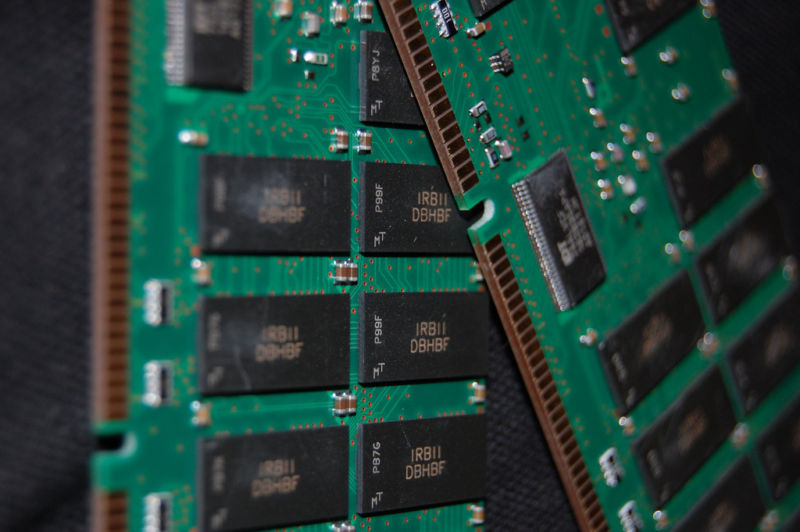
I’m a simple person. To me, a computer consists of three parts: data that goes in and out, operations that modify the data, and storage that holds the data. It is no different for quantum computing, though all three parts of the solution are still undefined: no one is exactly sure of what medium is best to represent and transport data. Different ways to encode operations are being fought over.
We're probably the furthest from having a solution when it comes to memory. But a new laser-hammer approach to storing qubits might be a step forward.
Screwdrivers for atomic physicists
In a quantum network, quantum information (or qubits) will be transported using light—single photons of light hold a qubit. But that means you also need a way to store photons, which are famous for moving very fast. One option is to store the qubit in the quantum state of a very cold gas; this works, provided you can emit the qubit as a photon later on.
To store quantum information in a gas, physicists usually take the very careful approach. By contrast, this latest bit of research hammers the gas, forcing it, like a sulky teenager, to tidy away its qubits.
First, let’s deal with the common aspects of both approaches. Our view of the atoms in the gas can be very simple: an atom can be in one of three states. There are two states that are almost at the same energy, called the ground state and the storage state. The ground state is where the atom normally resides. The storage state is where the atom should end up after absorbing a photonic qubit.
The atom cannot flip directly between these two states. It has to go via a third state, called the transfer state. The third state has a high energy, which matches the energy of the photon holding our qubit. To put the qubit into the storage state, we send in the photonic qubit along with a stronger light source, called a control laser. The qubit is absorbed by the atom, putting it in the transfer state. It is then immediately removed from the transfer state and put into the storage state by the control laser. If the control laser continues to shine, the qubit gets pumped back to the transfer state and emitted as a photon again. Memory read and write achieved.
Turn off the control laser at the right moment and the qubit remains stuck in the storage state. It can be read out at any time simply by turning the control laser back on.
This scheme works really well, but the qubit has to have exactly the right energy (or wavelength). That generally means that the pulse of light that holds the qubit has to be very long, so these memories are slow and delicate.
Everything can be fixed with a precise hammer blow
Now, let’s take a look at the hammer approach.
We take the same gas with the same states, and the procedure to store a qubit is pretty much the same, with one change: the control laser is quite bright.
Turning up the laser power changes the atoms. The control laser grabs the atoms and tries to give them a good shaking. The transfer state is the only part of the atom that feels the shaking, and it responds by stretching and contracting. This splits the transfer state into two states with slightly different energies.
This sounds bad: the energy (wavelength) of our qubit photon doesn’t match the energy of either of the two states. But, if the qubit doesn’t have a well-defined energy, then we only need a vague overlap between its energy and that of the two transfer states. As long as we can manage that, the rest of the qubit storage system will work.
With the basic system in place, the researchers showed how flexible their storage system is. They showed that it has efficiency and fidelity on par with other memory systems. According to the researchers, it is also simpler.
One of the biggest advantages, though, is the ability to change qubit properties. Picture this: to store an incoming photon, we turn up the power on the control laser. A short, sharp zap is enough to absorb a photon qubit. But say we need the photon that comes out to have a specific energy. To do that, we use the control laser at a very low power to emit our qubit. The qubit that is emitted has a long duration and a precise energy.
Excellent, I’ll take two
What does all this mean?
First, if you picture this as a memory for some kind of quantum repeater in a network, it has a number of advantages: it’s fast(ish). The control pulses can be short and powerful, storing qubits as short pulses. It’s adaptive: we don’t need to know the exact wavelength of the incoming qubit, as long as it falls within some range that we are prepared to play with.
It is adaptive in another sense, too. Imagine that we have two quantum processing systems. One system requires that the qubit wavelength is well defined, while another required qubits with a short duration. The read/write system of the memory can deal with both and convert between the two.
It is very difficult to predict how this will all play out. Microwave qubits are the option for computation. But they suck for memory, and transmitting microwave qubits isn't likely to work well. At some point, these three systems will have to be linked: microwave systems for computation, photonic systems for transport, and atomic states for memory. How we will do that is still anybody's guess.
Nature Photonics, 2018, DOI: 10.1038/s41566-018-0279-0.
reader comments
17